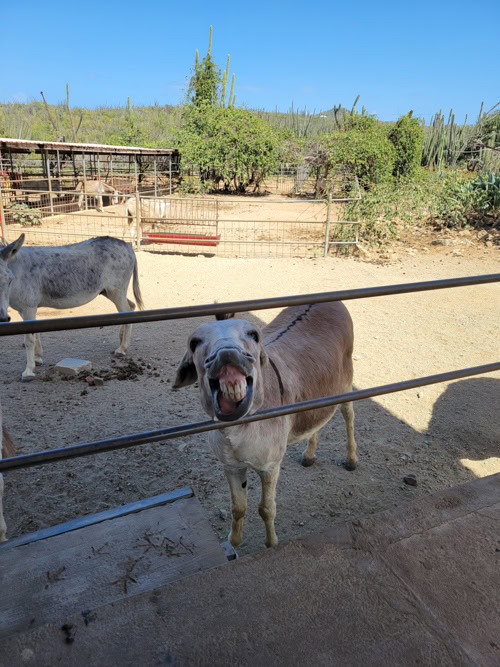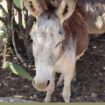
Go World Travel is reader-supported and may earn a commission from purchases made through links in this piece.
When planning a trip to Aruba I thought of all the exotic wildlife and natural beauty I would see. The magnificent waves of the Caribbean Sea pounding the cliffs, the volcanic crag of the shoreline with its crevices filled with salt deposits, sea turtles, stingrays, jellyfish and Venezuelan Troupial.
But donkeys were not on my radar.
Donkeys as Transportation

When researching things to do in Aruba before our trip, I came across the Donkey Sanctuary and knew I had to check it out. Donkeys, like palm trees, are not native to Aruba.
Originally from Sudan, they were brought to Aruba by the Spanish in the late 1400s to early 1500s to be used as transportation. The donkeys would carry passengers and freshwater along the dusty, cactus-lined roads.
When automobiles took over that job in the mid-1900s, donkeys were no longer needed. Illness and accidents began to cause a decline in their population, and they became almost extinct. This prompted the development of the donkey sanctuary which opened its doors on April 14, 1997.
History of the Sanctuary

Originally located in Santa Lucia, the sanctuary moved to their current, larger location at Bringamosa, Santa Cruz in 2016. Although the refuge originally opened in 1997 it did not allow visitors until 2004. Now they get about 30,000 visitors annually.
Safe from accidents in their sanctuary haven, new problems began to arise. One is the severe issue that comes along with inbreeding. The sanctuary decided to castrate all the male donkeys to prevent in breeding, but worried about making the Aruban donkey extinct.
The solution? Receiving four stallions from another donkey sanctuary at Bonaire, Caribbean Netherlands. This has helped to keep the donkeys safe and eliminate the issues of inbreeding.
Life at the Sanctuary for Donkeys and Volunteers

The sanctuary is currently home to 128 donkeys who share their space with chickens, roosters and peacocks. However, they largely ignore their feathered roommates, only chasing them on occasion.
The sanctuary is tended by about 30 local volunteers as well as volunteers from all over the world who stay anywhere from 2 to 12 months helping with daily chores. There are two apartments on the grounds that house out-of-town volunteers as well as a visitor’s center and gift shop.
Getting to the Sanctuary

The sanctuary is about 10 kilometers from the town of Oranjestad. It was a 25-minute drive through the center of Aruba from where I was staying with friends at Noord. On the drive there I had expectations of being surrounded by these feisty four-legged beasts.
As we walked through the sanctuary from the front gates the donkeys eyed us, but largely kept to themselves, with most hanging out around the covered porch and gift shop area. As soon as I climbed the steps I understood why – this is where the food is.
There is no admission fee to the sanctuary, but guests are welcome to purchase buckets of food to feed the donkeys or bring apples and carrots as special treats.
Best Tips & Tools to Plan Your Trip
Feeding the Donkeys

With buckets in hand, we were suddenly surrounded by hungry donkeys vying for our attention. Some were more aggressive than others and jostled each other to get to the food. I made sure to feed the smaller ones getting pushed back.
Some showed a giant toothy grin in hopes of getting a handful of food. With the food lying in my open palm, it only took seconds for the tasty morsels to be devoured. They even stretched their necks through the gates to scoop up the small pieces that fell to the ground.
All too soon the food was gone, and I walked through the sanctuary petting and snuggling the ones relaxing in the shade of the trees.
Donkeys as Stress Relief

Animals have a special way of relieving stress and anxiety, and donkeys are no exception. The donkeys are friendly, gentle and affectionate when you give them attention. Despite the heat of the day there was something soothing and relaxing about petting and snuggling these four-legged social creatures.
How to Help the Donkeys

There are currently about 30-35 donkeys still roaming free on the island. And if these last free donkeys ever find themselves in need of a home, they will likely find an open gate, helping hands and plenty of hugs from visitors at the sanctuary.
Along with cuddling and feeding the donkeys, visitors can make an impact long after they’ve left by sponsoring or adopting a donkey to help cover costs.
Hesitant to leave, I’m hoping this was not my one and only visit to the sanctuary. The donkeys help to make Aruba “One Happy Island!”
For more information about the donkeys, you can visit their website at www.arubandonkey.org.
Read More:
Author Bio: Christina Lewis is an educator, writer, and book reviewer based in Kansas City. She has had articles and short stories published with an educational publisher and online magazines. She loves to travel with her family and write about her experiences.
- Discover Claremont, California Along Historic Route 66 - December 6, 2024
- Three Sites to Soothe the Soul in Kyoto, Japan - December 5, 2024
- 13 Essential Tips For Women Traveling in Morocco - December 4, 2024

